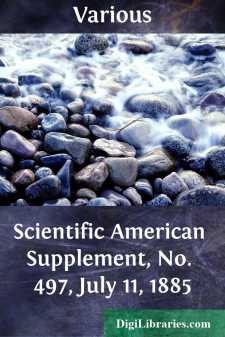Categories
- Antiques & Collectibles 13
- Architecture 36
- Art 48
- Bibles 22
- Biography & Autobiography 813
- Body, Mind & Spirit 142
- Business & Economics 28
- Children's Books 14
- Children's Fiction 11
- Computers 4
- Cooking 94
- Crafts & Hobbies 4
- Drama 346
- Education 46
- Family & Relationships 57
- Fiction 11829
- Games 19
- Gardening 17
- Health & Fitness 34
- History 1377
- House & Home 1
- Humor 147
- Juvenile Fiction 1873
- Juvenile Nonfiction 202
- Language Arts & Disciplines 88
- Law 16
- Literary Collections 686
- Literary Criticism 179
- Mathematics 13
- Medical 41
- Music 40
- Nature 179
- Non-Classifiable 1768
- Performing Arts 7
- Periodicals 1453
- Philosophy 64
- Photography 2
- Poetry 896
- Political Science 203
- Psychology 42
- Reference 154
- Religion 513
- Science 126
- Self-Help 84
- Social Science 81
- Sports & Recreation 34
- Study Aids 3
- Technology & Engineering 59
- Transportation 23
- Travel 463
- True Crime 29
Scientific American Supplement, No. 647, May 26, 1888
by: Various
Categories:
Description:
Excerpt
I have the honor this evening of addressing a few remarks to you upon the subject of influence machines, and the manner in which I propose to treat the subject is to state as shortly as possible, first, the historical portion, and afterward to point out the prominent characteristics of the later and the more commonly known machines. The diagrams upon the screen will assist the eye to the general form of the typical machines, but I fear that want of time will prevent me from explaining each of them.
In 1762 Wilcke described a simple apparatus which produced electrical charges by influence, or induction, and following this the great Italian scientist Alexander Volta in 1775 gave the electrophorus the form which it retains to the present day. This apparatus may be viewed as containing the germ of the principle of all influence machines yet constructed.
Another step in the development was the invention of the doubler by Bennet in 1786. He constructed metal plates which were thickly varnished, and were supported by insulating handles, and which were manipulated so as to increase a small initial charge. It may be better for me to here explain the process of building up an increased charge by electrical influence, for the same principle holds in all of the many forms of influence machines.
This Volta electrophorus, and these three blackboards, will serve for the purpose. I first excite the electrophorus in the usual manner, and you see that it then influences a charge in its top plate; the charge in the resinous compound is known as negative, while the charge induced in its top plate is known as positive. I now show you by this electroscope that these charges are unlike in character. Both charges are, however, small, and Bennet used the following system to increase them.
Let these three boards represent Bennet's three plates. To plate No. 1 he imparted a positive charge, and with it he induced a negative charge in plate No. 2. Then with plate No. 2 he induced a positive charge in plate No. 3. He then placed the plates Nos. 1 and 3 together, by which combination he had two positive charges within practically the same space, and with these two charges he induced a double charge in plate No. 2. This process was continued until the desired degree of increase was obtained. I will not go through the process of actually building up a charge by such means, for it would take more time than I can spare.
Fig.11.Fig.12.In 1787 Carvallo discovered the very important fact that metal plates when insulated always acquire slight charges of electricity; following up those two important discoveries of Bennet and Carvallo, Nicholson in 1788 constructed an apparatus having two disks of metal insulated and fixed in the same plane. Then by means of a spindle and handle, a third disk, also insulated, was made to revolve near to the two fixed disks, metallic touches being fixed in suitable positions. With this apparatus he found that small residual charges might readily be increased. It is in this simple apparatus that we have the parent of influence machines (see Fig. 1), and as it is now a hundred years since Nicholson described this machine in the Phil. Trans., I think it well worth showing a large sized Nicholson machine at work to-night (see Fig. 11, above).
In 1823 Ronalds described a machine in which the moving disk was attached to and worked by the pendulum of a clock. It was a modification of Nicholson's doubler, and he used it to supply electricity for telegraph working....












